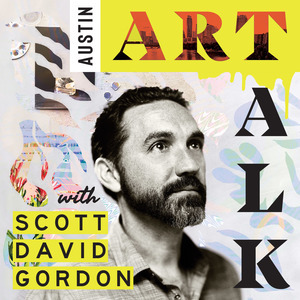Madeline Irvine - Naturally Curious
Episode 35 · July 7th, 2018 · 55 mins 33 secs
About this Episode
"I just love learning from the work. Just leaving it open and learning. It’s part of my being in the world. I try to be patient with myself and my artwork. There were years where it felt like it didn’t connect to the larger art world. But I just had to keep working. And I think you never know what’s coming unless you keep working, unless you keep that thread going. I think developing as a person is a part of what goes into the work. Who you are and what you think about and what's important to you is what comes out in the work whether you want it to or not."
Madeline Irvine uses a hyper saturated salt solution to draw and paint works on paper that reference the ocean and recently try to address issues around climate change and the importance of buffer zones. When the water evaporates from the paper it leaves behind crystalline salt structures that grow independent of any control or intentions imposed upon them. Beyond the climate change issues, these salt paintings and drawings are beautiful and fascinating simply as works of art on their own. But our impact on nature is a difficult and potentially depressing subject that none the less needs to be brought up. One hope is through this work people will be more aware of how these issues relate to their lives and explore what they can do to help.
In addition to being an artist Madeline has also had many jobs in the arts including administration, teaching studio art and art history, being a curator, and as an arts writer and critic. She has always been curious and very much into reading and her upbringing simultaneously gave her a love of art and of nature. Those traits have kept opening doors for her and have helped her learn about herself and the world.
There is a lot of wisdom in this interview and I was excited to sit down with Madeline knowing the breadth of her experience in the arts. If you can be sure to check out her current exhibition in Ft. Worth listed below.
Some of the subjects we discuss:
Artistic origins
Country home/Nature
Art School
The Ocean
School 33 Arts Center
Art History
Writing about art
Austin artists
Painting journals
Losing the thread
The Salt work
Control/Open
Buffer zones
Mangrove Forests
Climate change
Making more work
Being of service
Buffer Zone by Madeline Irvine
Fort Worth Community Arts Center
July 6 - July 27, 2018
Reception: July 6, 2018; 6 - 9pm
"I am a multidisciplinary artist whose focus is the natural world. The ecological history of the oceans is the source of my current work. Covering 70% of the planet, the ocean is larger than we can fully comprehend, and one of the great unexplored regions of the earth.
I work intuitively and in partnership with natural elements, incorporating chance into the process of making the work. Salt and water are essential elements necessary for all life, and in my artworks they interact, creating the unexpected. I draw with a sea salt solution. As the mixture dries, salt crystals grow in reaction to their environment, leaving records of the process as they change from an amorphous liquid to light catching solids. I research the ocean at large, and it is the knowledge of how the ocean and its elements work that fuels my imagery.
The Buffer Zones exhibition concentrates on mangrove forests, one of the three buffer zones between ocean and shore. These fertile zones – coral reefs, giant kelp forests and mangrove forests – feed a huge percentage of marine life and protect our shores from the full force of the seas. Mangroves are extremely adaptive trees, and here I focus on their roots, which live undersea for half each day. During the ebb tide, the roots breathe in oxygen for the trees.
Since I began working with the ocean in 2013, climate change is rapidly changing the undersea landscape and life. Coral reefs (1/3 of the Great Barrier Reef, for example) are dying and giant kelp forests are endangered. The marine life they support is disappearing. It is my hope that with an awareness of the impact of climate change in the ocean, people will explore how they can make small or large changes in their lives to help preserve the natural world as we have come to know it. For now, mangrove forests are holding on, a beacon of hope in changing times."
Banner image: Above and Below by Madeline Irvine
This interview has been edited and condensed for clarity.
Intro music generously provided by Stan Killian
Episode Links
- Madeline Irvine - website
- Buffer Zone by Madeline Irvine | Fort Worth Comunity Arts Center
- In Fort Worth, from Murakami to Meta-ish — Sightlines
- Mangrove and coral Reef Ecosystems - Coral.pdf
- The Sea Around Us - Rachel Carson
- School 33 Art Center
- Frida: A Biography of Frida Kahlo: Hayden Herrera
- Night Studio. A Memoir of Philip Guston
- Madeline Irvine Archives - The Austin Chronicle
